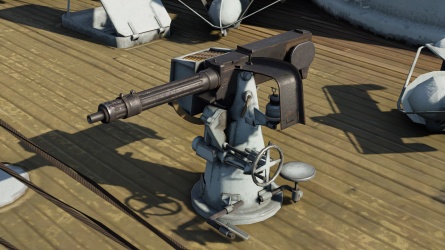40 mm/39 Vickers-Terni mod.1915/1917, Modif.1930 (40 mm)
Contents
Description
40 mm/39 Vickers-Terni mod.1915/1917, Modif.1930 is an upgraded modification of the earlier gun, able to fire rounds with a significantly larger explosive filler.
Vehicles equipped with this weapon
- RN Andrea Doria
- RN Bartolomeo Colleoni
- RN Bolzano
- RN Da Verazzano
- RN Dardo
- RN Leone
- MAS 441
- RN Tigre
General info
Tell us about the tactical and technical characteristics of the cannon or machine gun.
Available ammunition
| Penetration statistics | |||||||
|---|---|---|---|---|---|---|---|
| Ammunition | Type of warhead |
Penetration @ 0° Angle of Attack (mm) | |||||
| 10 m | 100 m | 500 m | 1,000 m | 1,500 m | 2,000 m | ||
| HE-F | HEF* | 3 | 3 | 3 | 3 | 3 | 3 |
| Shell details | ||||||||||||
|---|---|---|---|---|---|---|---|---|---|---|---|---|
| Ammunition | Type of warhead |
Velocity (m/s) |
Projectile mass (kg) |
Fuse delay (m) |
Fuse sensitivity (mm) |
Explosive mass (TNT equivalent) (g) |
Ricochet | |||||
| 0% | 50% | 100% | ||||||||||
| HE-F | HEF* | 610 | 0.9 | 0 | 0.1 | 55 | 79° | 80° | 81° | |||
Comparison with analogues
Give a comparative description of cannons/machine guns that have firepower equal to this weapon.
Usage in battles
Describe the cannon/machine gun in the game - its distinctive features, tactics of usage against notable opponents. Please don't write a "guide" - do not impose a single point of view, but give the reader food for thought.
Pros and cons
Summarise and briefly evaluate the weaponry in terms of its characteristics and combat effectiveness. Mark pros and cons as a list.
Pros:
Cons:
History
The first notable anti-aircraft gun for the Regio Marina (Royal Italian Navy) was the 40 mm/39 Vickers-Terni mod.1915/1917. A licensed model of the British Vickers 2-pounder Mark II "pom-poms", the guns were starting to show their age by the 1930s. While capable against the slower and fragile biplanes of World War I, the new generation of all-metal monoplanes was going to render the guns obsolete as the British themselves would learn in World War II. The Regio Marina started to seek a replacement, but in the meantime, they decided to make some upgrades to the design. The Modif. 1930 mount variant replaced the 25-round feed belts with 50-round drums and the rate of fire was increased from 1,920 rounds per minute to 2,000 rounds per minute. It was only two years later when the 37 mm/54 Breda Mod.32 was adopted, but the state of Italian industry meant that it wasn't fully phased out by World War II and was still present on warships such as the RN Dardo and RN Leone.
Media
Excellent additions to the article would be video guides, screenshots from the game, and photos.
See also
- 40 mm/39 Vickers-Terni mod.1915/1917 (40 mm) - original variant.
External links
Paste links to sources and external resources, such as:
- topic on the official game forum;
- other literature.




